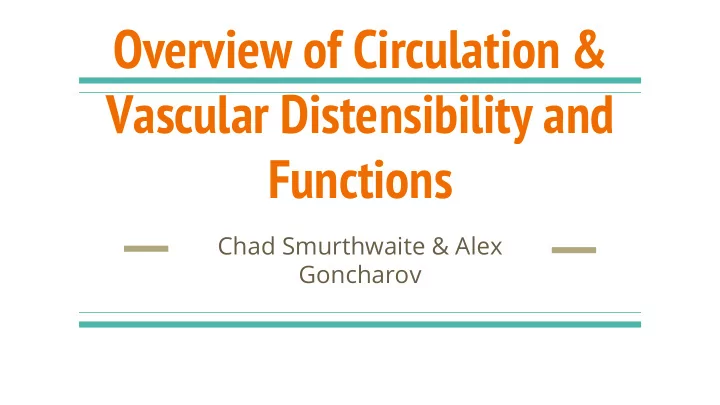

Overview of Circulation & Vascular Distensibility and Functions Chad Smurthwaite & Alex Goncharov
Chapter 14 - Overview of the Circulation; Biophysics of Pressure, Flow and Resistance
Blood Distribution aorta arteries arterioles Heart capillaries vena cava veins venules
Blood Distribution Continued Pulmonary - 9% Heart - 7% Arterial System Arteries - 13% Arterioles and Capillaries - 7% Venous System Veins, Venules, and Venous Sinuses - 64%
Arterial System Made of two types of vessels Conductance Vessels: Largest arteries with the thickest lumen near the heart. They contain much more elastin that allows them to expand and recoil as the heart ejects blood allowing a constant flow of blood. Resistance Vessels - Smaller arteries that contain more smooth muscle that constrict and relax to allow vasoconstriction and vasodilation
Venous System Capacitance Vessels: Veins with large lumens and thin walls that allow expansion for storage of blood.
Capillaries Capillary Beds: Smallest blood vessels that allow for exchange of gases, hormones and nutrients for most tissues in the body.
Blood Pressure Throughout the Circulatory System Pressure ranges between 120 and 80 mmHg in large arteries. Pressure then falls off. Venous system very low pressure system.
Blood Flow Flow = Rate of flow: Ohm’s law ΔPressure/ Proportional to the pressure difference Resistance Inversely Proportional to the resistance
Conductance and Poiseuille’s Law Conductance: A measure of the blood flow through a vessel for a given pressure difference. Conductance = 1/resistance Conductance ∝ Diameter 4 Poiseuille’s Law
Types of Flow Laminar Flow: When blood flows in streamlines, with each layer remaining the same distance from the lumen. Turbulent Flow: Blood is flowing in all directions in the vessel and continually mixing within the vessel.
Series vs. Parallel Circuits Series Circuits: When blood vessels are arranged in series Parallel Circuits: When blood vessels branch and converge R total = R 1 + R 2 + R 3 + R 4 …..
Autoregulation of Tissue Blood Flow (Perfusion) Autoregulation: The automatic adjustment of blood flow to each tissue in proportion to the tissue’s requirements at any moment. Metabolic Theory: When blood flow is too low to meet metabolic needs, oxygen levels decline and metabolic products accumulate. Metabolic factors- low oxygen, increases in hydrogen ions, potassium, adenosine, and prostaglandins. Myogenic Theory: When vascular smooth muscle responds directly to a passive stretch by increased tone, which increases blood flow. Both work together to determine the final autoregulatory response for a given tissue
Chapter 15 - Vascular Distensibility and Functions of the Arterial and Venous Systems
Vascular Distensibility and Compliance Vascular Distensibility: The ability of a blood vessel wall to expand and contract passively with changes in pressure. All blood vessels are distensible Allows for non pulsatile flow at the capillaries Reservoir function of Veins: can expand to store 0.5 to 1.0 L of extra blood
Distensibility Veins are 8x more distensible than arteries Pulmonary arteries are 6x more distensible than systemic arteries.
Compliance (Capacitance) Total quantity of blood that can be stored in a given portion of the circulation
Volume-Pressure Curves Arterial vs. venous distensibility Sympathetic stimulation/inhibition
Delayed Compliance - stress relaxation Works when blood volume is added or lost
Functions of Arterial vs. Venous Systems Arterial Pressure Pulsations The difference between systolic and diastolic is pulse pressure Affects Pulse Pressure: 1. stroke volume output of the heart 2. compliance of arterial tree
Abnormal pressure pulse contours
Pulse Pressure Transmission
Venous Pressure - Central Venous Pressure vs Peripheral Venous Pressure 1. Right Atrial Pressure (Central Venous Pressure) Pressure taken in vena cava -- right before right atrial pressure Values: Normal = 0.0 mm Hg Can increase to 20-30 mmHg in heart failure Lower limit -3 to -5 mm Hg
Venous Resistance low resistance - compressions can lead to collapses
Peripheral Venous Pressure Pressure driving blood back to heart is about 7 mm Hg. If there is pressure gradient from veins to the heart, blood will flow back to the heart. Valves/Muscles Pumps
Recommend
More recommend